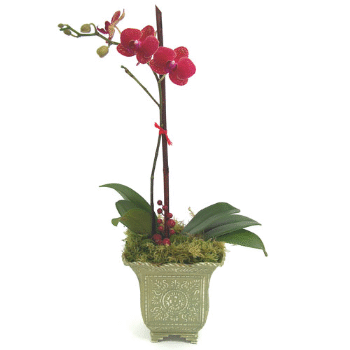Dtps., A New Orchid?

What is a DTPS. Orchid?
Many people are very familiar with Phalaenopsis or moth orchids. But what is Doritaenopsis? Well, this orchid is a moth orchid hybrid, a cross between the very popular Phaleanopsis orchid and and a Doritis orchid.
Perhaps you have seen these orchids in stores or nurseries and you might have seen them in books.
Like its parents, this orchid is a real beauty. It is usually a smaller plant than its larger relative, Phalaenopsis. It is substantially smaller than the very large (usually white) Phalaenopsis that are sometimes seen in stores. As a smaller plant it can fit into smaller places like on a window sill or small corner table.
Like Phalaenopsis, these orchids are easy to grow and are considered a great beginner orchid. The culture is very similiar to Phalaenopsis orchids.
Check here for more detailed information on Phalaenopsis orchids and their culture. This will give you a good idea about the cultural needs of Dtps. orchids.
Hybrids of these two genera are becoming very common as they often produce offspring with interesting and different traits than Phalaenopsis.
One common result of these hybrid crosses is that the offspring often will have multiple flowering spikes. This is a great addition to the already remarkable beauty of the elegant Phalaenopsis flower spikes. It adds an interesting dimension to the classic Phalaenopsis look, in addition as adding more blossoms in general.
When they have more blooms they often bloom longer than the parent orchids. Another point that has encouraged their hybrid forms is that they typically have a wider range of colors than the traditional parents. One that has come on the orchid scene recently is the Dtps. Kenneth Schubert 'Blue Angel'. It is a plant that has somewhat remarkably blue flowers. Blue flowers like black flowers are more rare among flowers in general and among orchid genera, in particular.
Care of these orchids is relatively easy. Like Phalaenopsis they like bright, indirect light, about 1500 foot candles. Window sills are good but only if they do not get direct sunlight. Often (and this of course depends on your growing situation) an East or North window will work well. They like to dry out somewhat after waterings and like Phalaenopsis they do not like to have the roots sit in water or be damp ALL the time. Like Phalaenopsis they are prone to root rot and crown rot. It is best to fertilize after the roots are already wet from a watering and use fertilizer at one quarter strength of the label recommendation. Try to fertilize at least once a month during the growth phase of the plant.
Dtps. orchids are interesting plants and should make a wonderful addition to your orchid growing family.
Return to the top of the Dtps. Orchid Page
Return to the Orchids Plus More Home Page
Home | Customer Service & Contact Information | Site Map | Security & Privacy


